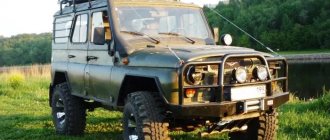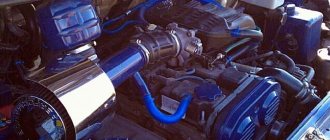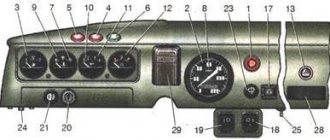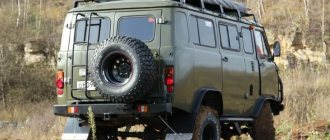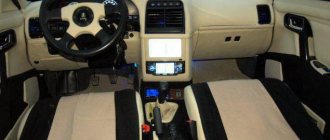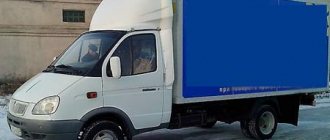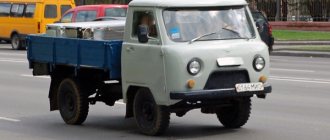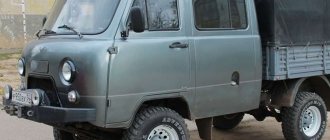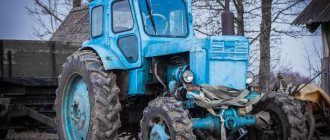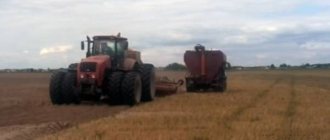- home
- Media center
- Articles
- Tuning the ZIL-131 cabin
Menu
- News
- Articles
- Video materials
- Photo materials
- Publication in the media
- 3D tour
11.03.2021
Tuning the ZIL-131 cabin is not performed so often. This procedure is intended rather for those who love their craft. Any structural improvements can not only improve the interior and exterior design of the car, but also lead to a number of problems. Therefore, tuning should be performed only on the basis of an understanding of the design features of the entire technical device.
Ideas for tuning a Soviet ZIL truck with your own hands
Tuning of the ZIL-130 is carried out with the aim of improving the appearance of the machine, increasing its performance characteristics and changing functionality. The vehicle is reliable and durable. But over decades of operation, its design has become outdated, components and mechanisms have become unusable or worn out to a critical condition. Remodeling a car with your own hands is an interesting and creative activity. It can be carried out in stages and in several directions.
Pickup cab
The cabin was used from the ZIL 131, in the northern version (former polar drilling station). The fitting showed that the cabin refused to fit into its proper place, so the author had to subject it to a major alteration. The bottom and power structures of the cabin were redone, in addition, the pedal mounting unit was moved 150 millimeters forward.
Zil-130 the very beginning of the project
It was decided to use the box formed as a result of reconstruction as a container for multimedia systems, and a subwoofer also found its place there. The top of the box is closed with an aluminum lid, on which there is an armrest with a glove compartment and places for glasses.
Cabin
Most often, a truck is converted into a pickup truck by removing the bulky body from the frame. To match this style, you should start improving the cabin outside and inside.
For this purpose, the following modifications are carried out:
- Replacing the bumper and radiator grille. A wide product with fangs and powerful headlights is installed. Depending on the chosen design, the bumper is coated with nickel or black powder paint. The radiator grille is made independently from stainless steel rods or purchased at a specialized store.
- Soundproofing of the cabin. The old coating is removed and a multilayer material with shielding aluminum foil is glued in its place. Leather or its substitute is attached to the outside. The lower part of the cabin is covered with mastic, which absorbs noise that occurs while driving.
- Seating improvements. You can limit yourself to replacing the upholstery with a new material that is wear-resistant. It is advisable to remove the sofa with dented springs and put in its place new pneumatic chairs with adjustment and armrests.
- Installation of a modern audio system. There is enough space in the cabin to install powerful speakers that create surround sound. The control panel is well complemented by a satellite navigator.
- Furniture arrangement. The best option is a shelf located above the windshield. For ease of use, its doors are made in a sliding version. A chest is placed next to the driver's seat for storing various small items.
If this does not contradict current traffic rules, then fairings and LED strips are attached to the outside of the cab.
We improve the comfort of the car owner
The key drawback that affects the level of comfort is the lack of sound insulation. This is one of the first reasons why tuning the ZIL-131 cabin is usually performed. This is due to the purpose of freight transport. It was originally produced for the Armed Forces.
Drivers of such trucks usually deal with the problem of strong noise and vibration on their own. For this purpose, the casing material in the cabin is dismantled and a layer of another material is laid underneath it, which can dampen vibration and perform a protective function against noise. The following options are usually used as the latter:
- stizol;
- vibroplast;
- bombs;
- biMast, etc.;
The metal surfaces of the lower part of the ZIL-131 cabin are treated with mastic. It muffles the noise level that appears while driving.
At the same time, the sealing elements on the cabin doors are inspected to identify the presence of gaps and backlashes. Reducing structural noise and excessive rattling improves the level of comfort when operating the truck.
Considering that the last sample of ZIL-131 left the factory assembly line in 2002, the dermantine-covered seats gradually fell into disrepair. In addition, such material can become very hot in the summer season, which leads to discomfort in the driver’s seat.
In this case, tuning the ZIL-131 or ZIL-130 cabin consists of upholstering the driver and passenger seats. It is being replaced with a more durable material that provides improved performance. To achieve this goal, the upholstery is simply fastened with staples.
Many people perform cabin tuning simply by completely replacing the old factory ones. Replacement work is not difficult. Therefore, in most cases, it is done on its own without contacting car service specialists. In some cases, it is possible to install seats that are equipped with an adjustment system and comfortable armrests.
When performing sound insulation, it is recommended to replace the old cladding material. This will also give the ZIL-131 cabin a more stylish and modern appearance. In addition, some install a filter in the cabin and inspect the heating device.
Another inexpensive and effective option to add attractiveness to the interior is to retrofit it with a strip with LED elements. Such illumination will not only fill the cabin with attractiveness: by placing an LED strip near the board with automobile instruments, it will be possible to clarify the necessary information at any convenient time, even in the dark.
Some people, in terms of tuning the ZIL-131 cabin, install a modern audio system. There is plenty of space for this in the cabin. It is recommended to install a satellite navigator on the control panel.
A shelf is attached above the windshield. This procedure is performed for convenience while driving. In addition, sliding doors are provided. A small chest is installed near the driver's seat, designed to store small items needed on the road.
Body
The ZIL-based dump truck has a powerful and strong frame designed for high dynamic loads. This is an advantage in terms of reliability of the modernized car.
Heavy and voluminous structures for various purposes can be installed on a solid base.
There are the following options for altering the car body:
- Cargo compartment. It is executed in the form of a stationary part combined with the body. Arches for an awning or a monolithic metal canopy are installed on the sides. The tailgate, similar to Ford pickups, tilts back. There is space for a spare wheel and a spare parts box.
- Passenger salon. Powerful safety arches are made. It is better to use a profile pipe with a cross section of 100x50 mm in a straight or arched form. Multilayer walls with foam inside are made or ready-made facade panels are taken. Car seats are screwed directly to the frame.
- Loader. A crane-manipulator is installed on the bottom. It is better to use a mechanism with a telescopic boom to increase the range of the lifting device. Such a vehicle can be used to perform loading and unloading operations, transporting large and heavy objects and materials.
- Change house. A ready-made or home-made booth made of timber or a steel frame covered with shields is installed on the platform. The cabin houses furniture necessary for camping life (bunks, tables, benches). To ensure vital functions in winter, a heating stove is installed. The bull is used for travel, hunting and fishing, and harvesting in the field and forest.
ZIL 130 tuning
Customizing means that you will most likely have to have more than one car to create a new Custom. For example, Ford components, in particular the Ford E-250, are excellent for our native Zilka. Ford has always been distinguished by high-quality parts, powerful engines, and a solid and strong frame. An excellent donor for a ZIL that has deserved an upgrade over many years of work.
And it’s worth noting that combining the dimensions of Ford and ZIL is not a big problem. Let's take a closer look. Donor Ford has a length of somewhere around six meters. The weight of this device is quite a bit, six tons. The car is equipped with a 4.3 liter engine with an automatic transmission. All components and the body itself are installed on a solid and strong spar frame.
Frame and suspension
If the machine is not planned to be used for economic purposes, then its frame is shortened and the technological components and structures are subsequently restored.
The frame is shortened using the following method:
- Calculations and markings on the side members. It is advisable to remove pieces of metal from the middle of the parts. This way it will be possible to preserve the shaped parts at their front and rear ends.
- Cutting the frame and driveshaft. It is better to do this with a grinder to achieve smooth edges. Cleaning cut areas with abrasive material.
- Welding of workpieces. Reinforcing elements are applied to the seams. The working field is cleared of scale and rust. The metal is coated with primer and paint.
- Adjusting the driveshaft. It is carried out similarly to the procedure for shortening the frame. To strengthen the joint, reinforcement rods are welded to it.
- Replacing the fuel tank. Reservoirs with a capacity of 80-100 liters are installed. Shortening a tank yourself requires a lot of time and skill.
The suspension is made lower and softer. After removing the large plate, the springs become shorter, allowing them to be hidden under the bottom. Additionally, new shock absorbers with adjustable height are installed. The wheels of the car are equipped with alloy wheels, with which the tuned ZIL looks stylish and beautiful. If the car is to be converted into a passenger version, then the second pairs are removed from the rear axle, and the axle itself is shortened to the required size.
Auto Club ZIL 131
This truck, distinguished by its increased cross-country ability, was designed on the basis of the ZIL-130 truck family, which for that time (mid-60s) had an advanced design and a powerful 8-cylinder engine. The new vehicle was intended to replace the model of the all-wheel drive army truck ZIS-151 and its modification ZIL-157, which, in fact, repeated the appearance and design of American-made military trucks, which were supplied from the USA to the USSR within the framework of Lend-Lease - the allied assistance in the fight against Nazi Germany. By the beginning of the 60s, these machines were completely outdated and no longer met the needs of the armed forces of the Soviet Union.
The decision to develop and subsequently produce at the ZIL factory facilities a series of unified trucks for the needs of the army and solving civilian problems was made in 1956. Surprisingly, work on creating a new car was in full swing - this is partly due to the use of individual parts of the experimental ZIL-128 vehicle, which successfully passed a number of tests. At the end of the same 1956, the first model of the ZIL-131 , equipped with an in-line 6-cylinder powerful engine. After 3 years, the new product of the domestic automotive industry has successfully passed a number of factory and state tests, showing its best side. As a result, the start of mass production on an industrial scale was planned for 1961, but due to certain problems, which were mainly of a technological nature, the factory conveyor was launched only in 1967.
The all-wheel drive new product had a classic-looking hood layout and was equipped with a V-shaped 8-cylinder carburetor engine; the designers provided a mechanism for disabling the front axle. Among other things, the ZIL-131 was equipped with a foam-oiled air filter, a single-disc dry clutch, a 5-speed gearbox with synchronizer and a 2-speed transfer case. The machine control is equipped with a hydraulic booster.
Soon a number of modifications with electrical equipment without monitors, truck tractors, and also modifications with a diesel engine were released. Particular attention must be paid to the use of ZIL-131 and its modifications for military purposes. Based on the truck, a number of combat and special vehicles were created and put into service, namely: rocket artillery combat vehicles, universal minelayers, transport-loading vehicles for anti-aircraft missile systems (SAM), fuel tankers and many others. In addition, the ZIL-131 and its various models were supplied to various countries of the socialist camp, as well as to many friendly countries located in Asia and Africa, where it also showed its best performance.
In total, during its production (1967-1990), ZIL produced slightly less than 1 million units of this truck and all its modifications. From 1990 to 2002, this production was transferred to the factory facilities of the Ural Automobile Plant (UAZ). Currently, the ZIL-131 is not produced, but on the streets of many cities and villages you can still see this truck, which at one time became a kind of symbol of its era.
Engine and exhaust
The main problems of the power plant are high fuel consumption, noise during operation and toxicity of exhaust gases. This can be solved by replacing the motor with a more modern and economical unit, but this is expensive.
There are the following options for improving the car engine:
- Equipping the hood with soundproofing materials. The power plant itself is mounted on vibration-absorbing gaskets. The engine compartment is lined with a special cloth, and the cracks and holes are pre-sealed. Noise reduction is achieved by fine-tuning the operation of each part and replacing worn gaskets.
- The carburetor unit is converted into a diesel engine. This solution will allow you to achieve fuel savings of 20-25%, reducing the risk of fire due to a leak or in an accident. The method consists of altering the injection system, removing the spark plugs and plugging the holes from them. If you follow the work technology, you can achieve excellent results at minimal cost. Subsequently, this will allow you to save a lot when operating the car.
- Improvement of the exhaust system. When the car was developed and began to be produced, environmental issues were not given as much attention as they are now. The simplest solution is to install a catalyst. This device almost completely neutralizes exhaust. However, it is expensive and has a small resource. It is more difficult and cheaper to make a muffler on your own. To make it you will need several stainless pipes of different diameters. They are inserted into each other, metal shavings are poured into the cavity and compacted, dampening the noise.
Prices and useful tips
The cost of reworking a car depends on its technical condition, the degree of wear and the wishes of the owners.
The price of tuning varies within the following limits:
- cabin - 5-15 thousand rubles;
- body - 20-100 thousand rubles;
- suspension and frame - 50-80 thousand rubles;
- engine - 60-125 thousand rubles;
- external painting - 20-30 thousand rubles.
The modification should begin with the power plant. After its modernization, it will make sense to continue work. The next step is changing the body. When the car takes its final shape, you can move on to installing additional elements and finishing.
Restoration of the ZIL-131 car
The craftsmen completely restored the ZIL-131 army truck and brought it to perfect condition.
The car was produced in 1985 and was purchased from the storage of a military unit. The condition of the truck was satisfactory, but it was decided to do a complete restoration of the vehicle. The photo below shows a detailed photo report on the repair and restoration work of the army ZIL-131. Original condition of the car.
Next, the disassembly process began, body parts and cladding were sent for sandblasting.
The first step was to prepare and paint the frame.
We went through and repaired all the bridges.
Next came the turn of the engine and gearbox, everything was completely repaired.
The assembly process continues.
The cabin was completely repainted and new electrical wiring was installed.
New tires were installed.
And here it is, a beautiful, fully restored ZIL-131 army truck.
We are building ZIL 131 - Residential rogue 4+1 sleeping place
We are building ZIL 131 - Residential rogue 4+1 sleeping place
Maka » 11 Feb 2015, 22:50
This cool car fell into my hands, ZIL-131 (Modification station D 90), of course, with all-wheel drive, and not just any drive, but 6x6 and a mechanical winch. This car has never seen asphalt in its life, all the paint is original, one layer, not tinted, it just never drove, it was parked in a box.
Tasks that this machine must perform:
The project is being built for autonomous living of 4 people +1, on a folding bed, for comfortable living for an unlimited time, in the winter and warm seasons. This car is primarily for covering the rear of club everyday life. For the most part, this is a mobile home for a large enough team, practical and durable, not for use in evacuation. The cross-country ability of the vehicle will allow you to reach almost any camp. A single-axle trailer is planned for the vehicle for transporting club equipment, an ATV, etc.
The kung will be equipped with a dry closet with an exhaust hood. Use of the toilet only when living with the family; in the case of the men's team, the dry toilet is removed and the toilet room is used as a storage room. Two-tier sleeping places make the living space more spacious. There are 4 permanent beds, it is possible to use a folding bed in the center to create an additional bed. This concept will allow up to 12 people to gather inside for meals.
ZIL-131
ZIL 131, side view
ZIL 131, front view
ZIL 131, rear view
Winch ZIL-131, with factory cable winding, preservative fabric removed.
Photo inside the wing, original paint
And of course the USSR quality mark
Cabin view:
Ideal preparation for the assigned tasks. On the opposite side of the entrance, there is an almost finished kitchen block, where all that remains is to install a sink and a gas stove.
The second tier of the bed is folded:
The second tier of the bed is open:
There is a sofa against the left wall, the back of which transforms into a second tier-bed. On the opposite side there was a lot of equipment that had floated away, well, this is for the best, we will remove all the unnecessary ones and install two more berths from a similar vehicle. Under the berths there are also metal drawers painted with hammer paint; each door has a handle with a locking mechanism, which prevents the doors from opening spontaneously on bumps. As standard, the kung is equipped with an autonomous diesel stove OV-65 and an FVUA filter and ventilation unit. The kung has two niches, accessible from the outside. Inside the kung there is a P159 radio and a light control panel. All the documentation from the kung has been preserved, these are 4 large special bags completely stuffed with literature. It’s gratifying that they have never been used, the radio stations are in their original form, the buttons are filled with preservative.
Radio station R-159
Basic layout of the kung:
Dimensions of the Kung ZIL 131:
width: 2.25 m height: 1.8 m Height along the slopes: 1.5 m Length: 4 m Cook volume: 13.5 m3 Area: 9 m2
Driving experience ZIL-131
Maka » 12 Feb 2015, 00:10
I've driven about 200 km in this car so far. First things first.
When I got behind the wheel, I realized that this was the first Soviet military vehicle in which ergonomic and comfort ideas were visible. I would call ZIL 131 a kind of pedant among its own kind. The instrument panel seems to be from another time, it has a design! Just like the devices themselves. The car has a glove compartment! The seat is more like a sofa, it was made with an eye to passenger transport for increased comfort. The set of toggle switches at the bottom of the panel was apparently made by order! I was amazed when the front axle turned on, there was a toggle switch, a click and the front axle turned on! And a little light comes on on the instrument panel! The bridge can also be connected forcibly with just one lever, which has three positions. High, neutral, low, full. Those. If I'm driving on the highway and I need to engage the front end, I just flip the switch! Steering hydraulics “Go crazy”! The air brakes scare me, but people drive! I have only felt such brakes on high-tech foreign passenger cars. The pedals need to be lightly touched, otherwise the car stops dead in its tracks with all 6 wheels. The pneumatic signal is very powerful! There is an alternative to the beep on the steering wheel, electric. The gearbox is 5-speed, after GAZ66, it seems like something from the world of perfection, although you get used to 66 and then you don’t notice it anymore. ZIL's windshield wipers are pneumatic! those. powered by air! This was news to me!
